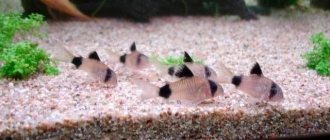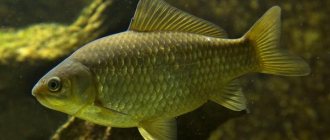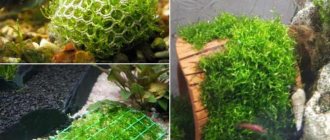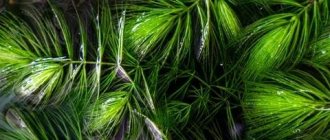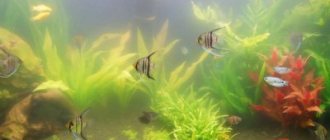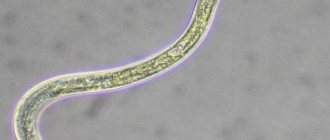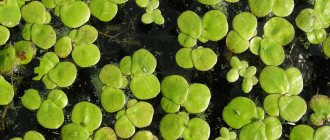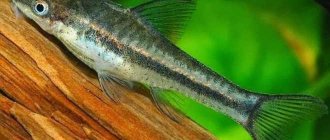Description
The name of the fish comes from two Greek words: “Corys” - “helmet” and “Doras” - “armor”. Corydoras really have a unique structure - protection of catfish from predators is provided by overlapping bone plates located throughout the body along the back, which create a kind of shell that resembles armor. At the same time, catfish are very peaceful, which makes them comfortable neighbors for a variety of types of aquarium fish.
These fish have a convex back and a rounded tummy, and a relatively short body.
Different types of catfish differ mainly in color and size (from 4 to 12 cm). Otherwise they are very similar.
Fish look for food at the bottom of the aquarium, so nature has thoughtfully endowed them with a lower mouth.
Catfish have three pairs of antennae near their mouths: one pair on the lower jaw (they are hardly noticeable) and two pairs above the upper jaw. The antennae have several functions.
Firstly, catfish use them as a kind of tool for digging in the ground to search for food. This is one of the advantages of choosing corydoras as an inhabitant of a home pond - they perform the function of natural cleaning of the aquarium, since they pick up leftover food at the bottom.
Secondly, they act as a full-fledged organ of touch. Thanks to their antennae, corydoras easily navigate in muddy water.
The pectoral fins of the fish have characteristic sharp rays. They perform a protective function. Therefore, planting fish in the aquarium should be done very carefully so as not to injure your hands.
The color of corydoras can be very diverse. In some species it is monotonous, in others there are stripes or spots, and there are also albino forms with a white body and red eyes.
Habitat of Corydoras
The natural habitat of Corydoras in nature is the rivers of Central and South America (in the Amazon, Paraguay, and Orinoco river basins).
They prefer silty, standing or slow-moving water. Catfish constantly swarm in the soil of rivers in search of food, and dense vegetation serves as protection from predators.
This region is characterized by the drying up of rivers at the end of the rainy seasons. To survive, these fish have learned to swallow air from the surface of the water, although they do not have a special organ for breathing, like labyrinth fish. Thus, corydoras absorb oxygen through the intestines. Such living conditions make them hardy and unpretentious, which has become another plus for aquarists.
Popular aquarium species of Corydoras
Speckled Corydoras (Corydoras paleatus)
The main color is gray-olive, there are many dark spots on the body, and the abdomen has a pinkish-golden hue. Fish of this species grow up to 4-6 cm.
Corydoras panda
The main body color is light with a pinkish tint, there are three black spots: near the tail, on the dorsal fin and near the eyes (like pandas). The size of adults is 5-6 cm.
Corydoras venezuelanus
There are two color options for fish of this species: “orange” - the average size of adults is 5 cm, “black” - they grow up to 7-7.5 cm. “Black” coloring is a black or chocolate-colored body with a light gray belly and red -brown fins. “Orange” coloration - the body is rusty orange, under the dorsal fin there is a large black or green spot with a turquoise tint, and there is a bright red spot on the head.
Corydoras sterbai
The fish looks very original due to its color: the main color is dark brown or deep black, light spots are scattered throughout the body, which turn into stripes in the area behind the gills. The fins are yellow or bright orange and may have a reddish tint. Adults grow up to 6-7 cm.
Corydoras pygmaeus
One of the smallest species of corydoras: the male reaches 2.5 cm, the female - 3 cm. The general color of the fish of this species is gray-green, with a black stripe stretching from the eye to the tail, which ends in a dark spot. There are white stripes above and below the black stripe.
Golden Corydoras (Corydoras aeneus)
It has a characteristic bronze coloration with a yellow tint on the fins. In an aquarium, females grow up to 7 cm, males are slightly smaller. A peaceful, schooling fish that fits perfectly into a community aquarium.
Corydoras julii
In an aquarium, it reaches a size of up to 5 cm. It has a very colorful color: many black spots are scattered on the cream or grayish main color, and a dark stripe stretches along the entire body. The fins are transparent, there is a black spot on the dorsal fin.
Character of the Corydoras catfish
These fish are very peaceful and have a calm disposition. They prefer to spend most of their time at the bottom of the aquarium and swim in layers of soil. Catfish are excellent orderlies: they clean water from various food residues. There is one drawback: the turbidity of the water increases. Therefore, aquarium owners need to buy filters from a specialized store.
They like to hide in different shelters. They will feel more confident in the company of several more catfish of the same species.
Types of Corydoras
There are about 200 species worldwide.
Of these, the most famous are the following types of corridors:
- Mottled;
- Shterba;
- Golden;
- Adolfi;
- Leopard;
- Panda.
Let us briefly analyze each type from this list and describe their distinctive features.
Mottled
Body size is from 3 to 8 centimeters. Females are much larger than males. Color: there are albinos, most often olive with bright black spots. This type of catfish is resistant to temperature changes and can live in cold conditions.
Golden
A distinctive feature is the presence of a golden stripe along the body of the fish. For their normal existence, it is necessary to maintain the water temperature; it should not be too cold. Color: golden with silver shades. Under natural conditions, it lives in the waters of rivers in the city of Venezuela.
Leopard
It got its name because of its unusual coloring, similar to the skin of a spotted leopard. Natural habitat - Brazil and Peru. Males grow up to 7 centimeters in length.
Shterba
This is an unusual species of Corydoras catfish. These fish can camouflage themselves, changing color to match the local topography. The size of adult males reaches 4 centimeters. Color: dark brown.
Adolfi
Size: 5-8 cm. Natural habitat - South America. Color: Most of the body is light yellow, with a large orange spot on the top of the head. There is a black stripe on the eyes. It is also located along the entire back. Life expectancy is short. Feature: very shy.
Panda
This type of fish is small in size. Females are larger than males. Natural habitat - rivers of Peru and Ecuador. The coloring resembles that of a panda, hence the name. The most common colors are light and pink. A black stripe runs through the eyes, and there is a dark spot at the end of the tail. They reproduce only in warm water.
Maintenance and care
Corydoras are schooling fish. To make them feel comfortable, it is better to plant groups of 4-6 individuals in the aquarium. The maximum size the fish can reach is 9-12 cm. When choosing an aquarium, you should proceed from the fact that one pair of catfish requires about 30 liters of water.
Basic parameters for maintaining corridors:
Water
Corydoras are quite hardy and unpretentious fish. They easily adapt to different living conditions. However, in order for the fish to feel comfortable, it is recommended to avoid fluctuations in temperature and pH levels.
The water should be soft, which is as close as possible to natural conditions. But they can also live in hard water.
The optimal temperature is 22-25°C, pH=6.0-7.5, GH=4-18.
Partial replacement should be performed once a week in an amount of 25-30% of the aquarium volume.
Care should be taken to ensure good aeration and filtration. Corydoras are able to survive in turbid and dirty water, but this will mean that they will often have to rise to the surface of the aquarium to swallow air. And for other inhabitants, the lack of filtration and aeration is unlikely to create favorable conditions. Therefore, the aquarium should be equipped with a standard set of equipment: a filter (internal or external - depending on the volume of the aquarium), a compressor and a thermostat.
Priming
Catfish constantly crawl in the soil with the help of their antennae, so it should not contain sharp elements that can injure their faces.
Too large a fraction is also not recommended. If the soil is too coarse, the fish will not be able to reach the remaining food stuck under the stones. As a result, the accumulation of organic matter on the bottom will negatively affect the condition of the aquarium.
The best option is coarse sandy or small pebble soil measuring 3-5 mm.
Lighting
Corridors are twilight dwellers. Their main activity occurs at night. Diffused lighting will be comfortable for them. It will allow the fish to feel good, and you will watch how they amusingly squirm around in the ground. In bright light, they will constantly hide in thickets of plants or decorations.
Plants and space design
Corydoras are very fond of dense thickets; they prefer to rest in them during the day. Any plants can be used to form such areas.
You should also take care of shelter from driftwood or artificial grottoes, in which the fish will happily hide and relax.
Feeding Corydoras
These fish are very unpretentious in food; they can eat a variety of foods. But the key to their healthy and long life is a high-quality, balanced diet.
Today, manufacturers offer special food for Corydoras, rich in essential nutrients and omega-3 fatty acids, which ensure rapid healthy growth of fish.
An additional advantage of special feeds is that they quickly sink to the bottom and immediately become available to catfish. These foods include granules, tablets, discs, etc.
Catfish also eat frozen and live food: brine shrimp, bloodworms, tubifex, aulophorus, daphnia, and coretra. Don't forget about herbal supplements, these are all kinds of tablets, disks from spirulina and chlorella algae.
It is important to avoid overfeeding; you need to feed 1-2 times a day, in small portions, and do a fasting day once a week.
Content
Despite the unpretentiousness and undemanding nature of these catfish, there are still some subtleties that you need to know.
The volume of the aquarium is determined depending on the number and size of the fish that will live in it. In the case of corydoras, bottom area is crucial, since these creatures are bottom-dwelling. Experts recommend adhering to the formula: per 20-25 cm of the total length of fish (excluding tails) there should be 0.5 m² of bottom area. As a rule, for a flock of 4-8 individuals, take an aquarium of 50-70 liters.
Water parameters. Corydoras can live in a fairly wide range of conditions, which is good as they can be kept with a variety of fish. For example, they can withstand temperatures from 20 to 29 degrees, hardness from 0 to 18 and acidity from 5.8 to 7.8. However, the following are considered optimal conditions: 20-26°C, 0-12 deg. and 6.4-7.4. The content of nitrates, nitrites and ammonium in water should be minimal.
Bottom arrangement . It is better to put fine sand or gravel on the bottom. It is very important that it does not contain sharp particles that could injure the antennae of the catfish. On a dark background, corydoras look bright and catchy, but a light background makes them faded.
. In several places it is a good idea to make shelters from soft stones and driftwood. Both of them should not release any substances into the water! There should not be a lot of shelters, as they will reduce the bottom area, which means the fish will be cramped.
Plants can be planted quite densely, but be sure to leave free space from which it will be convenient for the corridors to select food. It is better to take plants in the form of spreading bushes, and you can also use moss and ferns. Do not forget that catfish can dig up plants, so they must have strong roots or they will need to be additionally secured in the ground. There should also be free access to the surface of the water. Keep this in mind if you have floating plants in your aquarium.
Compatibility
Corydoras themselves are very peaceful fish. They live in the bottom layers of the aquarium and do not cause trouble to their neighbors.
Catfish get along well with various types of viviparous fish (for example, guppies, swordtails, mollies and platies); their neighbors can also be neons, angelfish, barbs and tetras, and various types of dwarf cichlids.
But under no circumstances should they be housed with large aggressive cichlids (acaras, astronotuses), since even the “armor” of corydoras will not be able to protect them from the attacks of such neighbors.
Conflicts and clashes may arise between catfish and other species of bottom-dwelling fish, so it is better to avoid proximity to bots and gyrinocheilus.
You should also carefully choose neighbors based on similar living conditions. For example, some tropical fish species require water temperatures that are much higher than what is comfortable for Corydoras. This means that such a neighborhood will not be ideal.
Conditions for keeping Corydoras
For most Corydoras, the conditions of detention are similar. Soft and slightly acidic water is good for them. Although at home they can easily get used to water of any hardness. They often live in so-called “black water” - water saturated with decay products of fallen leaves and all kinds of snags, due to which a high content of tannins and humic acids is formed; “black water” has a strong antibacterial effect. Therefore, it is very good for corydoras to have a snag in the aquarium; it will give them shelter and a sense of security, and protect them from diseases.
The soil needs to be dark, sandy or fine gravel, without sharp edges on which they can injure themselves while digging through the soil in search of food. In addition to snags for shelter, they need shelters shaded by plants. Spreading bush plants, mosses or ferns are well suited for this, as well as floating plants will give them confidence in safety.
Reproduction and breeding of corydoras
Breeding corydoras is a simple process and is accessible even to novice aquarists. It will require a spawning aquarium. But first things first.
Selection of manufacturers
The first stage is the selection of manufacturers. Catfish are ready to breed at about 8 months.
Poor parents should be carefully selected, since they exhibit weak sexual dimorphism. If you look closely, the female can be identified by its richer color, rounded short dorsal fin and larger size (males are slightly smaller in size).
Before boarding the fish for spawning, it is necessary to start feeding them with high-protein food 2 weeks in advance. For breeding, one female and 2-3 males are usually chosen.
Preparing a spawning aquarium
An aquarium with a volume of about 15 liters will be enough, depending on the number of fish. No special arrangement is required inside.
There is no need to use soil in the spawning tank, but plants with large leaves (live or artificial) will not be damaged. It could be Anubias, for example. You should also put a flat stone or grotto, which will serve as an additional substrate for the eggs.
To stimulate spawning, it is necessary to create suitable conditions.
- Daily water changes in the spawning tank, in small portions, with fresh, preferably soft (osmotic) water. Second, the temperature of the fresh water should be several degrees lower than that in the spawning aquarium. The temperature drop should be stopped when it reaches 21-23°C.
- Enhanced aeration.
- Adding live food (aulophorus or tubifex) to the producers, this further encourages the fish to spawn.
Spawning process
The resettlement of producers is carried out in the evening. The spawning process itself occurs in the morning or during the day. Sometimes you have to wait several days for the start of spawning.
The whole process looks quite unusual. The males begin to chase the female throughout the aquarium. She lays eggs in the folded pelvic fins, and collects milk from the male in her mouth.
Then she selects a suitable place on glass, plant leaves or decorations, smears it with milk and attaches the eggs to them. This process is repeated several times.
During one spawning, one female lays about 200 eggs. Upon completion of spawning, the spawners can be returned to the general aquarium, as the fish do not have an expressed instinct to care for their offspring.
Caring for fry
It usually takes 5-6 days for the eggs to develop and the larva to appear. This is a fairly long period of time during which a large percentage of eggs can be affected by the fungus.
To minimize losses and speed up the development process, it is enough to raise the temperature in the spawning aquarium to 27-28°C and add a few drops of methylene blue to the aquarium. Within 3 days, larvae will emerge from the eggs. After their appearance, the temperature should be gradually returned to the optimal 22-25°C.
Reproduction of Corydoras catfish
Breeding Corydoras catfish is a complex and painstaking process. There is a lot you need to know to get a good result - large offspring.
- First you need to prepare a spawning ground - a place where all the optimal conditions are combined. Sexual maturity of an adult is reached at the age of 1-2 years. The spawning tank consists of live plants, 50 liters of water and smooth stones. The water temperature should be several degrees lower than in a regular aquarium (23-24 degrees).
- The reproduction of Corydoras fish differs from others in group spawning, which occurs in a certain way. It involves one female and several males. The most active male begins to swim after the female, then she chooses him and swallows the milk.
At the same time, a small pouch forms on her ventral fin, where eggs begin to form. Then the female chooses the most suitable place for her, for example, the glass of an aquarium or broad-leaved plants, coats it with milk and glues her eggs there.
This process is repeated with the remaining males. But at the same time, you need to make sure that the males do not eat the eggs. To do this, they are given dry food or moved from the spawning area to an aquarium.
This is how Corydoras catfish reproduce. After 5-7 days the larvae begin to hatch. When the fry swim independently, they can be moved to a community aquarium.
The spawning period, during which the eggs are formed, can last up to one year.
